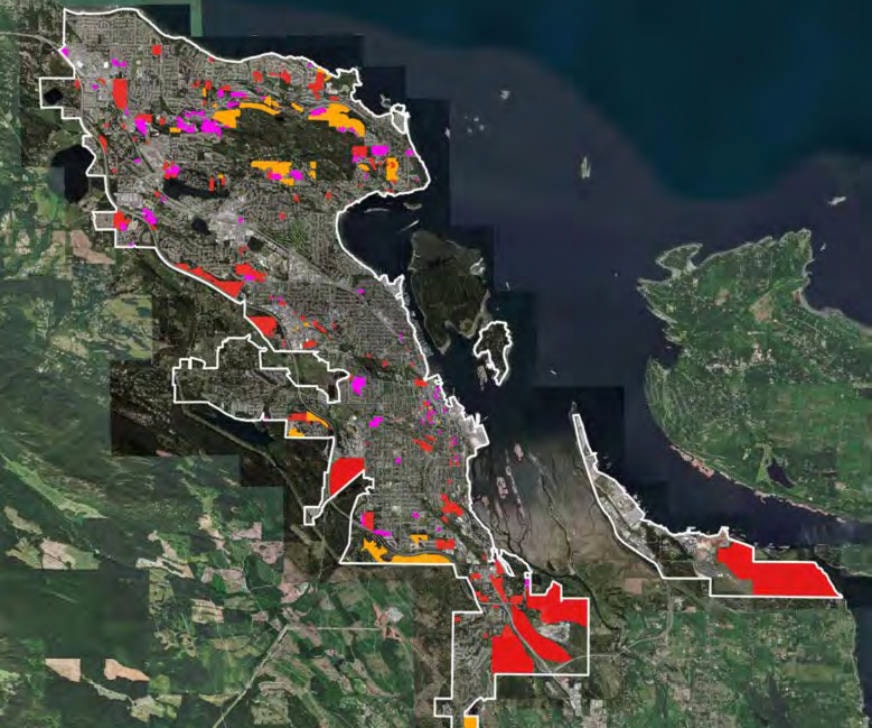The City of Nanaimo is making sure it has sufficient space for residents, businesses, industry and institutions as it gets started on long-term community planning.
At a meeting June 22, Nanaimo city council received a report on land inventory and capacity analysis meant to inform the ‘Reimagine Nanaimo’ strategic policy review process, including the official community plan review.
The report, prepared by Colliers International, found that over the next 25 years, “the city is expected to have enough capacity within its vacant and developable [residential] land to support future growth in all scenarios except … high growth, low density.”
The report found that the city will have sufficient commercial land, but will run out of industrial land by 2041 even with status-quo growth. The city could face “a few key challenges” with demand for institutional land, notably for schools and seniors’ housing and care facilities.
Dale Lindsay, the city’s general manager of community development, told councillors that studying demographics and land inventory and capacity are “foundational work” when embarking on strategic planning such as an OCP review.
“It’s really important to have an understanding of where do we think the community’s going to grow in the long term and what are our needs going to be in that time frame,” he said.
The demographics report is still in progress, but a staff report summarized some of the projections.
The city’s population is anticipated to grow somewhere between 0.9 per cent to 1.2 per cent per year between 2016 and 2046, bringing the population to a baseline of 126,600 or a high-growth scenario of 141,900.
Housing units are anticipated to increase from 39,200 in 2016 to 54,100 in 2046 under a baseline scenario or 60,200 under a high-growth scenario.
Employment projections adapted from the Regional District of Nanaimo’s regional growth strategy suggest the number of jobs could increase from 46,200 in 2016 to 58,500 in 2046 or 63,800 with high growth.
Lisa Bhopalsingh, the city’s manager of community planning, talked about some of the challenges of long-term jobs projections and said for example, a virus pandemic, a mill closure or a major hospital investment could push projections toward baseline or high-growth, as the case may be.
“We can be confident, I think, in the next five to 10 years, and then as opportunities shift, we would, I think, look at revising that,” she said.
In terms of housing, the report suggests the city should look at allowing greater maximum building heights and higher densities and consider reducing parking requirements, especially for affordable housing projects.
The report suggests the city should “support the overall health of its existing retail nodes” rather than looking at ways of providing more commercial land. A strong focus on the downtown is suggested, with heavy emphasis on “active and transparent storefronts” that staff say can “alter consumers’ overall perception of a certain part of town.”
The report has a few suggestions for meeting industrial land needs. It recommends that the city encourage development of 11 hectares of lots in the Boxwood area south of the Nanaimo Parkway behind Cavallotti Lodge, consider Oceanview resort land in Cable Bay for industrial development, and look at amalgamation of 44 hectares of land just south of city limits suitable for industry.
The report’s institutional land analysis notes that school-age populations are expected to level off in the next five to eight years, but not before potential shortages of elementary and secondary school space. Staff say the city will need to work closely with the school district on long-range facilities plans.
“We would be looking to them for their analysis of what their forecasts are around the neighbourhoods, the facilities that they currently own, the capacity and where they see education going,” Bhopalsingh said.
Coun. Erin Hemmens said parts of the report reinforce some of what the city already has in place with its existing OCP, for example some of the recommendations around downtown revitalization. Bhopalsingh said part of the strategic policy review will be attempting to measure the impacts of current plans.
“We have policies that are working and getting us toward the densities of those walkable, more sustainable communities,” Bhopalsingh said. “So knowing and evaluating that going forward is an important piece of how we decide to tweak or shift with our updated Reimagine Nanaimo official community plan.”
The city said the land inventory and capacity analysis report cost $84,500 and the demographics report cost $20,100.
READ ALSO: City of Nanaimo plans for extreme weather over next 60 years
editor@nanaimobulletin.com
Like us on Facebook and follow us on Twitter
